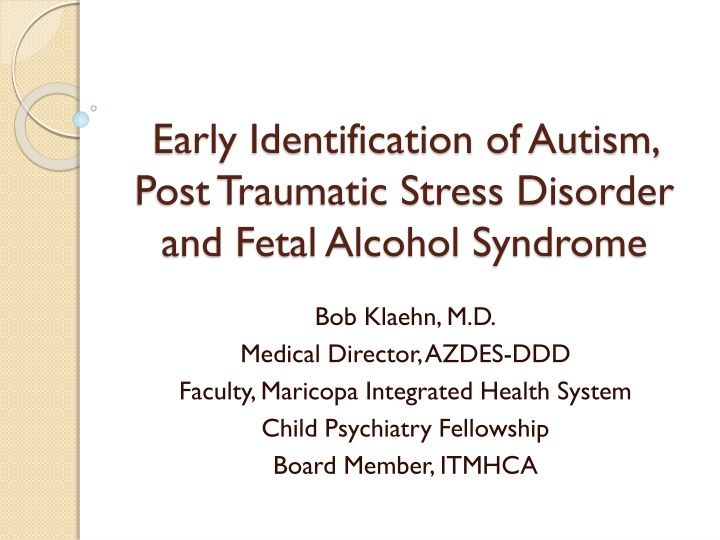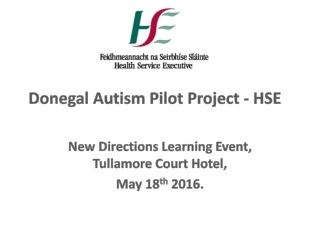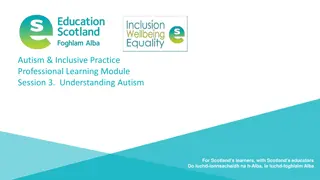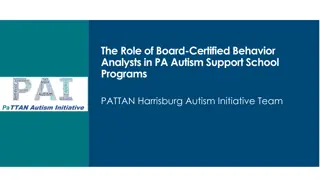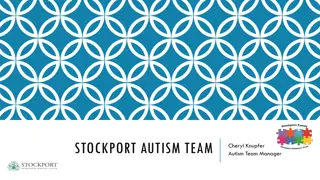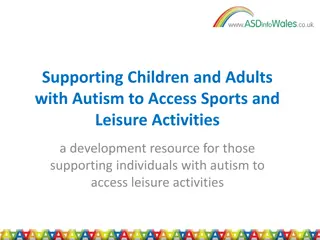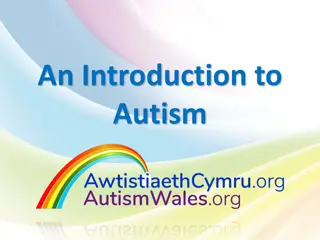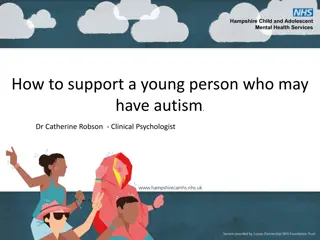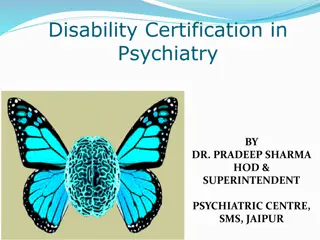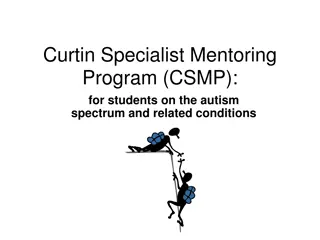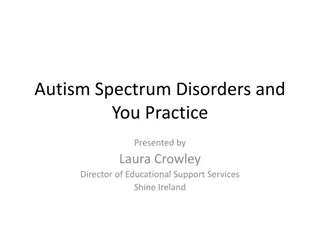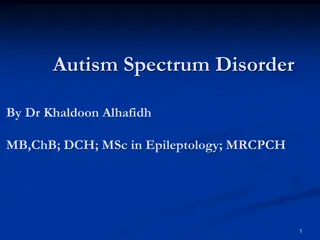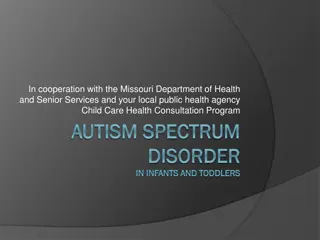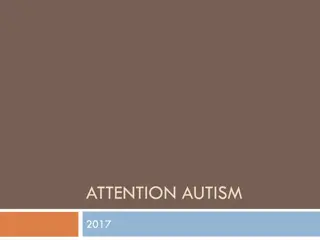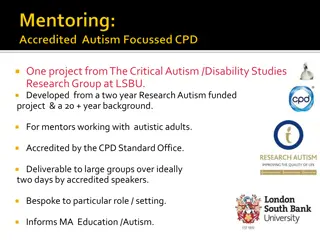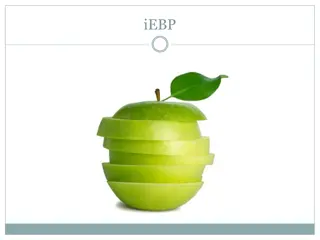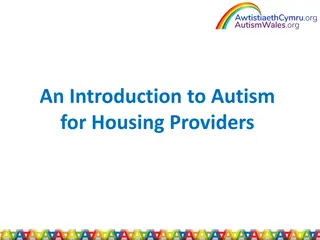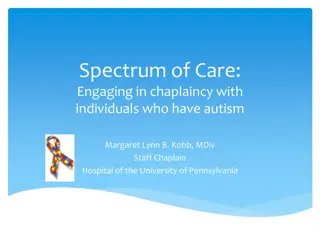Early Identification of Autism: Challenges and Tools
Understanding the early signs of autism is crucial for timely intervention and support. Despite common concerns from parents, delays in diagnosis still persist due to barriers such as lack of trained professionals. Tools like the M-CHAT play a vital role in screening for autism risk. Learn more about the journey towards early identification and overcoming diagnostic challenges.
Download Presentation

Please find below an Image/Link to download the presentation.
The content on the website is provided AS IS for your information and personal use only. It may not be sold, licensed, or shared on other websites without obtaining consent from the author.If you encounter any issues during the download, it is possible that the publisher has removed the file from their server.
You are allowed to download the files provided on this website for personal or commercial use, subject to the condition that they are used lawfully. All files are the property of their respective owners.
The content on the website is provided AS IS for your information and personal use only. It may not be sold, licensed, or shared on other websites without obtaining consent from the author.
E N D
Presentation Transcript
Early Identification of Autism, Post Traumatic Stress Disorder and Fetal Alcohol Syndrome Bob Klaehn, M.D. Medical Director, AZDES-DDD Faculty, Maricopa Integrated Health System Child Psychiatry Fellowship Board Member, ITMHCA
Onset of Autism In most cases (>50%) parents are worried in the child s first year of life By age 2, 90% of parents are concerned Common presenting problems include: language delay, worries that the child may be deaf and concerns about social deviance Unfortunately, delays in diagnosis are still common. Autism rarely develops after age three Volkmar and Klin, 2003
Barriers to Autism Diagnosis Lack of Trained Professionals Very limited requirement for residency training in Developmental Disabilities for Child Psychiatrists Exposure to training in Developmental Disabilities quite variable in Psychology Graduate Programs Very small numbers of Developmental Pediatricians (Physicians with the most familiarity of care of children with Autism) Nobody likes giving bad news (in reality, most parents are relieved that someone is validating their concerns).
Modified Checklist for Autism in Toddlers (M-CHAT) Designed to be filled out by the parents and a primary health care worker at the 18 month developmental check up 23 questions Excellent for screening for those at risk for Autism In Arizona: The Arizona Chapter of the American Academy of Pediatrics has distributed the M-CHAT to all pediatrician s offices In order to get an infant or toddler into DDD services, you must determine only that a child is at risk for Autism
M-CHAT: Key Questions Does your child take an interest in other children? Does your child ever use his/her index finger to point or indicate interest in something? Does your child ever bring objects over to you to show you something?
M-CHAT: Key Questions (2) Does your child imitate you? Does your child respond to his/her name when you call? If you point to a toy across the room, does your child look at it?
DSM-IV DSM-5 Autistic Disorder Rett s Disorder Childhood Disintegrative Disorder Asperger s Disorder Pervasive Developmental Disorder, Not Otherwise Specified (PDD, NOS) Autism Spectrum Disorder DSM-IV vs. DSM-5
Why continue to use the DSM-IV diagnostic criteria for Autism? The Division of Developmental Disabilities (DDD) continues to use the DSM-IV diagnostic criteria for Autism. Arizona Revised Statutes must be revised before the DSM-5 can be used Revision of Statute requires approval by the Legislature
DSM-IV Diagnostic Criteria for Autism A total of 6 of 12 diagnostic criteria must be met in the following distribution: At least two criteria from the category of Qualitative Impairment in Social Interaction At least one criterion from the category of Qualitative Impairments in Communication At least one criterion from the category of Restricted or Repetitive and Stereotyped Patterns of Behavior, Interests and Activities
Diagnostic Criteria for Autism: Impairment in Social Interaction 1a) Marked impairment in the use of multiple non-verbal behaviors such as eye-to-eye gaze, facial expression, body postures and gestures to regulate social interaction Examples: Trouble looking others in the eye Little use of gestures while speaking Few or unusual facial expressions Trouble knowing how close to stand to others Examples from: Autism Spectrum Disorders: A Research Review for Practitioners; Ozonoff, Rogers & Hendren, eds. (American Psychiatric Press, 2003)
Diagnostic Criteria for Autism: Impairment in Social Interaction 1b) Failure to develop peer relationships appropriate to developmental level Examples: Few or no friends Relationships only with those much older or younger than the child or with family members Relationships base primarily on special interests Trouble interacting in groups and following cooperative rules of games
Diagnostic Criteria for Autism: Impairment in Social Interaction 1c) A lack of spontaneous seeking to share enjoyment, interests, or achievements with other people (for example, by a lack of showing, bringing or pointing out objects of interest) Examples: Lack of joint attention Enjoys favorite activities, television shows & toys alone, without trying to involve other people Does not call other s attention to activities, interests or accomplishments Little interest in or reaction to praise
Diagnostic Criteria for Autism: Impairment in Social Interaction 1d) Lack of social or emotional reciprocity Examples: Does not respond to others, appears deaf Not aware of others; oblivious to their existence Does not notice when others are hurt or upset Does not offer comfort
Diagnostic Criteria for Autism: Impairment in Communication 2a) Delay in, or total lack of, the development of spoken language (not accompanied by an attempt to compensate through alternative modes of communication such as gesture or mime). Examples: No word to communicate by age 2 No simple phrases by age 3 After speech develops, immature grammar or repeated errors
Diagnostic Criteria for Autism: Impairment in Communication 2b) Trouble holding a conversation Examples: Trouble knowing how to start, keep going and/or end a conversation Little back and forth May talk on and on in a monologue Failure to respond to the comments of others Difficulty talking about topics not of special interest
Diagnostic Criteria for Autism: Impairment in Communication 2c) Stereotyped and repetitive use of language or idiosyncratic language Examples: Repeating what others say to him/her (echolalia, this may be immediate or delayed). Repeating words for videos, books or commercials at inappropriate times or out of context Using words or phrases that the child has made up or that have special meaning only to him/her Overly formal, pedantic style of speaking (sounds like a a little professor ).
Diagnostic Criteria for Autism: Impairment in Communication 2d) Play that is not appropriate for developmental level Examples: No imaginative play: little acting out scenarios with toys Rarely pretends an object is something else (for example, that a banana is a telephone) Prefers to use toys in a concrete manner(building with blocks) rather than pretending with them When young, little interest in social games like Peek-a-boo.
Diagnostic Criteria for Autism: Restricted Patterns of Behavior 3a) Encompassing preoccupation with one or more stereotyped and restricted patterns of interest that is abnormal either in intensity or focus Examples: Very strong focus on particular topics to the exclusion of other topics Difficulty letting go of special topics Interest in unusual topics (light bulbs, astrophysics, etc.) Excellent memory for details of special interest
Diagnostic Criteria for Autism: Restricted Patterns of Behavior 3b) Apparently inflexible adherence to specific, non- functional routines or rituals Examples: Wants to perform certain activities in an exact order Easily upset by minor changes in route (such as taking a different way home from school) Need for advance warning of any changes Becomes highly anxious and upset if routines or rituals are not followed
Restricted, Stereotyped and Repetitive Patterns of Behavior 3c) Stereotyped and repetitive motor mannerisms (such as hand or finger flapping or twisting, or complex whole body movements) Examples: Flaps hands when excited or upset Flicks fingers in front of eyes Odd hand postures or hand movements Spins or rocks for long periods of time Walks and/or runs on tiptoe
Restricted, Stereotyped and Repetitive Patterns of Behavior 3d) Persistent preoccupation with parts of objects Examples: Uses objects in ways not intended (opens and closes door on toy car instead of playing with it as a car) Interest in sensory qualities of objects (sniffs objects or looks at them from strange angles) Likes objects that move (fans, running water, spinning wheels) Attachment to unusual objects (string or orange peel)
DSM-5 Diagnostic Criteria for Autism Spectrum Disorder Must meet all three of these criteria: 1) Problems reciprocating social or emotional interaction -This can include: Difficulty establishing or maintaining back-and- forth conversations and interactions, Inability to initiate an interaction, and Problems with shared attention Problems with sharing of emotions and interests with others.
DSM-5 Autism Spectrum Disorder 2) Severe problems maintaining relationships - This can involve: A complete lack of interest in other people Difficulties playing pretend Difficulties engaging in age-appropriate social activities, Problems adjusting to different social expectations.
DSM-5 Autism Spectrum Disorder (2) 3) Non-verbal communication problems - This can include: Abnormal eye contact Abnormal facial expressions Abnormal tone of voice Abnormal use of gestures or postures An inability to understand these non-verbal signals from other people.
DSM-V Autism Spectrum Disorder (3) In addition, the individual must display at least two of these behaviors: Extreme attachment to routines and patterns and resistance to changes in routines Repetitive speech or movements Intense and restrictive interests Difficulty integrating sensory information or strong seeking or avoiding behavior of sensory stimuli
Why is Early Identification of Children At-Risk Important? Increasing evidence for the importance of early entry into treatment in minimizing risk of long-term disability from Autism (ASD) Multiple types of interventions target young children with Autism (or at risk for Autism) Early Intensive Applied Behavioral Analysis Developmental Individual-difference Relationship- based model (DIR) Floortime Denver Model TEACHH Model
Barriers to the diagnosis of Posttraumatic Stress Disorder A belief in Man s better nature A lack of diagnostic sophistication in public mental health (too many NOS diagnoses!)
Schwartz & Perry, 1994 on the impact of Early Trauma: In contrast to earlier belief that early trauma had little impact on the child, it is now recognized that early trauma has the greatest potential impact, by altering fundamental neurochemical processes, which in turn can affect the growth structure and functioning of the brain.
Lets review PTSD criteria from 3 Diagnostic Classifications Diagnostic Classification: Zero-to-Three Revised DSM-IV Diagnostic Manual: Intellectual Disability, (DM:ID) which adapts DSM-IV criteria for persons with Mild to Moderate ID and Severe to Profound ID
DSM-IV and DM:ID Criteria for Posttraumatic Stress Disorder Diagnostic Manual: Intellectual Disability (DM:ID) takes the DSM-IV criteria for and adapts them for persons with Mild-to- Moderate and Severe-Profound ID. DSM-IV: A. The persons has been exposed to a traumatic event in which both of the following are present: DM-ID: No adaptation.
DSM-IV DM-ID (1) the person has experienced, witnessed or was confronted with an event or events that involved actual or threatened death or serious injury, or a threat to the physical integrity of self or others No Adaptation Note: It appears that the range of potentially traumatizing events is greater for individuals with a lower developmental age. Posttraumatic Stress Disorder
DSM-IV DM:ID No Adaptation. (2) The person s response involved intense fear, helplessness or horror. Note: In children, this may be expressed instead by disorganized or agitated behavior. There is considerable evidence, however, of increased likelihood of disorganized or agitated behavior in individuals with greater levels of impairment. Posttraumatic Stress Disorder
DSM-IV DM:ID B. The traumatic event is persistently re-experienced in one (or more) of the following ways: B. No Adaptation. Mild to Moderate ID: No adaptation (1) Severe to Profound ID: Behavioral acting out of the traumatic experience is more common for individuals of a lower developmental age. Some cases of self-injurious behavior may be symptomatic of traumatic exposure. (1) Recurrent and intrusive distressing recollections of the event, including images, thoughts or perceptions. Note: In young children, repetitive play may occur in which themes or aspects of the trauma are expressed Posttraumatic Stress Disorder
DSM-IV DM:ID Mild to Moderate ID: No Adaptation, though frightening dreams without recognizable content are more likely in more impaired individuals (2) Recurrent distressing dreams of the event Note: In children, there may be frightening dreams without recognizable content Severe to Profound ID: Frightening Dreams without recognizable content appear to be more common in individuals with a lower developmental age. Posttraumatic Stress Disorder
DSM-IV DM-ID (3) Acting or feeling as if the traumatic event were recurring (includes a sense of reliving the experience, illusions, hallucinations, and dissociative flash- back episodes, including those that occur on awakening or when intoxicated). Mild to Moderate ID: No Adaptation Severe to Profound ID: Trauma-specific enactments have been observed in adults with Moderate to Severe ID. These episodes require judicious assessment in that they can appear to be symptoms of psychosis in adults. Note: In young children, trauma- Specific re-enactment may occur. Posttraumatic Stress Disorder
DSM-IV DM:ID (4) Intense psychological distress at exposure to internal or external cues that symbolize or resemble an aspect of the traumatic event No Adaptation (5) Physiological reactivity on exposure to internal or external cues that symbolize or an aspect of the traumatic event No Adaptation Posttraumatic Stress Disorder
DSM-IV DM:ID C. Persistent avoidance of stimuli associated with the trauma and numbing of general responsiveness (not present before the trauma), as indicated by three (or more) of the following: No adaptation Posttraumatic Stress Disorder
DSM-IV DM-ID Mild to Moderate ID: No adaptation Severe to profound ID: No Adaptation, but it may be difficult to assess in those with severe verbal limitations. (1) Efforts to avoid thoughts, feelings or conversation associated with the trauma Posttraumatic Stress Disorder
DSM-IV DM:ID No Adaptation. However, avoidance behaviors may be reported by caregivers as non-compliance (2) Efforts to avoid activities, places or people that arouse recollections of the trauma (3) Inability to recall an important aspect of the trauma No Adaptation, but assessment may be difficult Posttraumatic Stress Disorder
DSM-IV DM:ID No Adaptation. May be reported by caregivers as non-compliance (4) Markedly diminished interest or participation in significant activities (5) Feeling of detachment or estrangement from others No Adaptation. Caregivers may report that the individual isolates him or herself Posttraumatic Stress Disorder
DSM-IV DM:ID No Adaptation (6) Restricted range of affect Mild to Moderate ID: Many persons with ID do not have the same life expectations as the typically developed (those who are aware of their differences). Lack of abstraction may also decrease ability to think about the future. (7) Sense of a foreshortened future (e.g., does not expect to have a career, marriage, children, or a normal life span) Severe to Profound ID: this criterion may be of limited usefulness Posttraumatic Stress Disorder
DSM-IV DM:ID D. Persistent symptoms of arousal (not present before the trauma as evidenced by two (or more) of the following: No adaptation (1) Difficulty falling or staying asleep No adaptation Posttraumatic Stress Disorder
DSM-IV DM:ID (2) Irritability or outbursts of anger No adaptation (3) Difficulty concentrating No adaptation (4) Hypervigilance No adaptation (5) Exaggerated startle response No adaptation Posttraumatic Stress Disorder
DSM:IV DM:ID E. Duration of symptoms is more than a month No adaptation F. The disturbance causes clinically significant distress or impairment in social, occupational or other important areas of functioning No Adaptation Posttraumatic Stress Disorder
Developmental Responses to Trauma under 5 years old Fear of being separated from the mother or primary caretaker and excessive clinging Crying, whimpering, screaming, trembling and frightened facial expression. Immobility or aimless motion Regressive behaviors, such as thumb sucking, bedwetting and fear of darkness
Risk Factors for Child Maltreatment (National Center for Injury Prevention and Control, 2005) Disabilities or intellectual disability in children Social isolation of families Lack of caregiver understanding of the child s needs and child development Poverty History of domestic violence
Risk Factors for Child Maltreatment (National Center for Injury Prevention and Control, 2005) Substance Abuse in the family Caregiver stress and distress (including parental mental health conditions) Young, single, non-biological parents Negative caregiver-child interactions Caregiver beliefs and emotions that support maltreatment Community violence
Factors protecting against Child Maltreatment (National Center for Injury Prevention and Control, 2005) Supportive family environment/stable family relationships Nurturing caregiver skills Consistent household rules and monitoring of the child Adequate housing Parental employment Access to healthcare and social services Caring adults outside the family who serve as role models or mentors Communities that support caregivers
Prevalence of Trauma (National Technical Assistance Center for State Mental Health Planning, 2004) Up to 81% of men and women in psychiatric hospitals diagnosed with major mental illnesses have experienced physical and/or emotional abuse (67% experienced their abuse as a child) Each year, between 3.5 10 million children witness the abuse of their mother. Up to half of these children are abused themselves. Massachusetts Point-in-time medical review of adolescents in inpatient programs found 84% had a history of trauma
Prevalence of Trauma (National Technical Assistance Center for State Mental Health Planning (NTAC), 2004) 25% of infants ages 1-6 months are hit 50% of infants ages 6-12 months are hit History of trauma is pervasive in youth in Juvenile Justice system (especially minority youth) 93.2% of males and 84% of females reported a traumatic experience (Hennessey, 2004) 18% of females and 11% of males met full criteria for PTSD From a sample of incarcerated female juvenile offenders: 74% reported having been hurt or in danger of being hurt 60% reported being raped or in danger of being raped 76% witnessing someone being severely injured or killed
